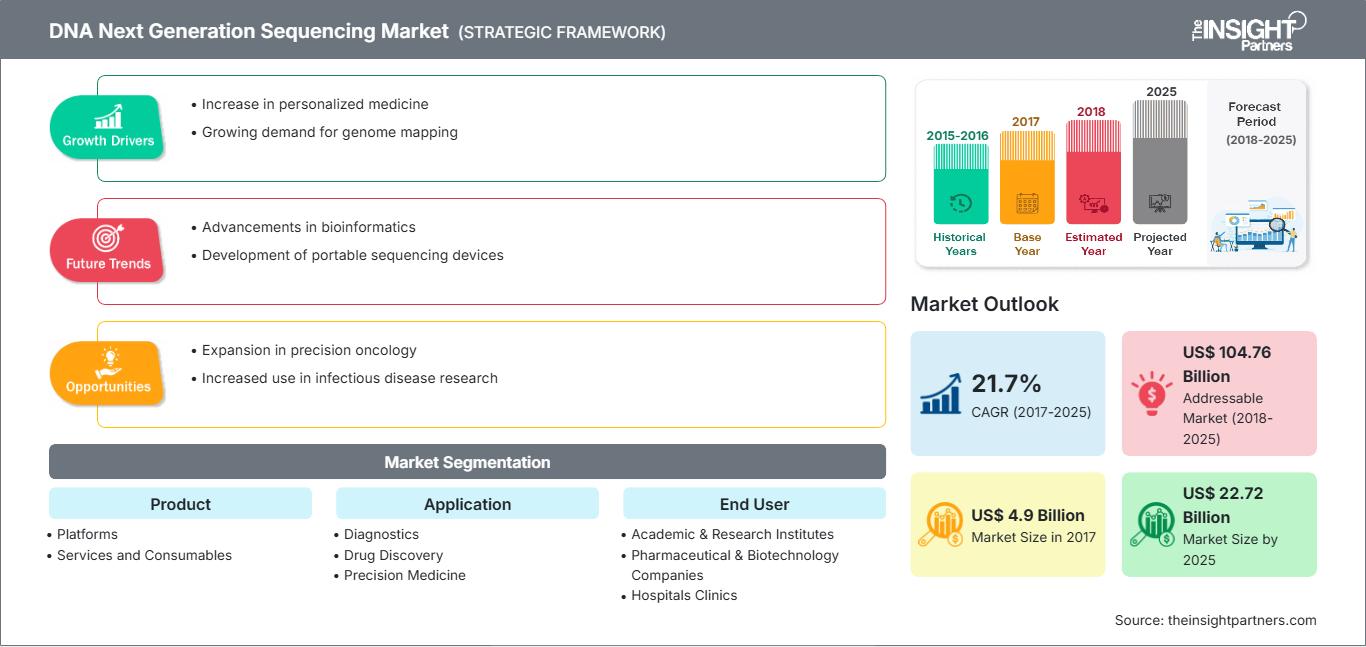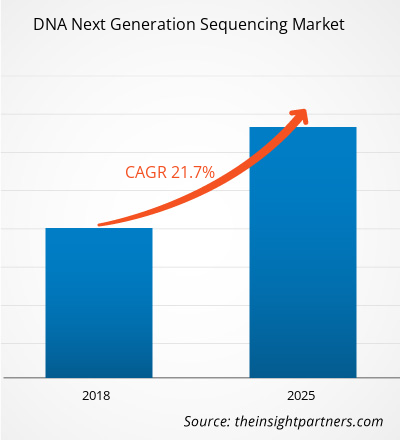[연구 보고서] 차세대 DNA 시퀀싱 시장 규모는 2017년 48억 9,850만 달러에서 2025년까지 227억 1,690만 달러로 성장할 것으로 예상되며, 2018년부터 2025년까지 연평균 성장률 21.7%로 성장할 것으로 예상됩니다.
차세대 시퀀싱은 고처리량 시퀀싱이라고도 합니다. NGS는 DNA 샘플의 염기쌍을 빠르게 시퀀싱할 수 있도록 합니다. NGS는 신약 개발 분야를 주도하고 개인 맞춤 의료, 유전 질환 및 임상 진단의 미래를 가능하게 합니다. 또한, 차세대 시퀀싱(NGS)은 확장성, 초고처리량, 빠른 속도를 통해 전체 유전체의 뉴클레오타이드 순서를 규명할 수 있는 대규모 병렬 시퀀싱 기술입니다. 후속 시퀀싱 반응을 위한 샘플 준비 단계를 포함하기 때문에 DNA 사전 시퀀싱은 전체 시퀀싱 프로토콜에서 가장 중요한 프로세스 중 하나입니다. 글로벌 의료 분야에서 NGS는 임상 검사 분석, 검사 및 질병 진단에 꾸준히 통합되고 있습니다. 약물유전체학 분야에서는 NGS가 신약 개발 과정을 가속화하는 데 널리 활용되고 있습니다. DNA 차세대 시퀀싱 시장의 성장은 전 세계 암 발생 건수 증가, 연구 증가, 연구소와 시장 참여자 간의 협력 증대, DNA 차세대 시퀀싱 응용 분야 확대 및 시퀀싱 기술의 기술적 발전에 기인합니다. 그러나 숙련된 전문가 부족은 DNA 차세대 시퀀싱 시장 전체 성장에 중대한 영향을 미칠 것으로 예상됩니다.
이 보고서의 일부, 국가 수준 분석, Excel 데이터 팩을 포함하여 모든 보고서에 대한 사용자 정의를 무료로 받을 수 있을 뿐만 아니라 스타트업 및 대학을 위한 훌륭한 제안 및 할인을 이용할 수 있습니다
DNA 차세대 시퀀싱 시장: 전략적 통찰력

- 이 보고서의 주요 주요 시장 동향을 확인하세요.이 무료 샘플에는 시장 동향부터 추정 및 예측에 이르기까지 데이터 분석이 포함됩니다.
시장 분석
시퀀싱 가격 하락 및 시퀀싱 방법의 기술 발전이 차세대 DNA 시퀀싱 시장을 견인합니다.
최근 몇 년 동안 차세대 시퀀싱 가격이 크게 하락했습니다. 2000년 인간 유전체 시퀀싱 비용은 37억 달러였으며 완료까지 13년이 걸렸습니다. 그러나 최근 몇 년 동안 비용은 2006년에 1,000만 달러로 감소했고, 2012년에는 더욱 하락했으며, 시퀀싱에 소요되는 시간도 단축되었습니다. 일루미나(Illumina)와 로슈(Roche)와 같은 주요 차세대 DNA 시퀀싱 시장 참여 기업들은 비용 효율적이고 시퀀싱 시간을 단축하는 획기적인 기술을 도입했습니다.
게다가 분자생물학 분야의 발전은 시퀀싱 절차를 향상시켰습니다. 지난 몇 년 동안 많은 업계 참여자들이 혁신적인 NGS 기술을 개발했습니다. 예를 들어, Pacific Biosciences의 Sequel과 Oxford Nanopore의 PromethION이 있습니다. 또한, 시장을 장악하고 있는 세 가지 첨단 NSG 시스템으로는 Roche GS FLX(454), Illumina HiSeq 2000(Solexa), AB SOLiD(Agencourt)가 있습니다.
이 프로세스의 추가적인 수정 및 자동화는 시퀀싱 데이터를 지속적으로 증가시켰고, 시간 관리 효율을 향상시켜 연구자들이 인간 게놈 프로젝트의 주요 이정표에 도달할 수 있도록 했습니다. NGS는 시퀀스 기반 유전자 발현 분석을 아날로그 기법의 "디지털" 대안으로 제시합니다. 게놈 시퀀싱의 발전은 시퀀싱을 쉽고 정확하게 만들었습니다. 이러한 기술 발전은 가까운 미래에 DNA 차세대 시퀀싱 시장 규모를 확대할 것으로 예상됩니다.
제품 기반 인사이트
글로벌 DNA 차세대 시퀀싱 시장은 제품 기준으로 플랫폼, 서비스, 소모품으로 구분됩니다. 플랫폼 부문은 HiSeq 시리즈, MiSeq 시리즈, SOLiD, Ion Torrent, Pacbio Rs II 및 Sequel Systems 등으로 세분화됩니다. 또한 서비스 부문은 시퀀싱 서비스와 데이터 관리 및 분석 서비스로 세분화됩니다. 소모품 부문은 샘플 소모품 준비 및 기타 NGS 소모품으로 세분화됩니다. 소모품 부문은 2017년 DNA 차세대 시퀀싱 시장에서 제품 하위 부문 중 더 큰 점유율을 차지했으며 예측 기간 동안에도 유사한 추세를 보일 것으로 예상됩니다. 최신 NGS 플랫폼은 단일 분자 시퀀싱(SMS)이라는 새로운 시퀀싱 방법을 채택했습니다. 이 방법은 DNA의 사전 증폭을 필요로 하지 않으므로 PCR 관련 오류 판독이나 반복 영역에 대한 증폭 편향을 방지합니다. 지난 5년 동안 차세대 시퀀싱(NGS)은 연구에서 임상적 사용으로 전환되었습니다. 최소 14개국이 대규모 인구의 유전체 시퀀싱을 위한 이니셔티브를 구축했으며, 2025년까지 전 세계 6천만 명 이상의 유전체 시퀀싱이 이루어질 것으로 예상됩니다.
응용 프로그램 기반 인사이트
글로벌 차세대 DNA 시퀀싱 시장은 응용 프로그램을 기준으로 진단, 신약 개발, 정밀 의학 및 기타 분야로 세분화됩니다. 진단 분야는 2017년에 가장 큰 점유율을 기록했으며 향후 5~6년 동안 상당한 성장을 보일 것으로 예상됩니다. 진단 유전체 관리에 차세대 시퀀싱(NGS) 기술을 사용하려면 정밀성과 정확성이 필수적입니다. NGS 기술은 비용 효율적인 시퀀싱을 통해 전체 유전체 시퀀싱을 통해 환자의 유전체 정보를 확보하고 임상적 조치를 수행합니다. 차세대 시퀀싱은 궁극적으로 다양한 유전 질환 진단을 위해 기존 기술을 대체하고 있습니다. 이제 유전자별 접근 방식 대신 단일 검사로 대량의 유전자 세트를 분석할 수 있습니다.
최종 사용자 기반 인사이트
글로벌 시장은 최종 사용자를 기준으로 학계 및 연구 기관, 제약 및 생명공학 기업, 병원 및 진료소, 그리고 기타 최종 사용자로 세분화됩니다. 학계 및 연구 기관 부문은 예측 기간 동안 가장 높은 성장을 보일 것으로 예상됩니다. DNA 염기서열 분석은 과학자들이 특정 DNA 세그먼트에 포함된 유전 정보의 종류를 파악하는 데 도움을 줍니다. 예를 들어, 과학자들은 염기서열 정보를 이용하여 어떤 DNA 세그먼트에 유전자가 포함되어 있는지, 그리고 어떤 세그먼트에 유전자를 활성화 또는 비활성화하는 조절 지시가 포함되어 있는지 확인할 수 있습니다. 메릴랜드주 록빌에 있는 유전체 연구소(TIGR)는 무작위 또는 샷건 시퀀싱에 기반한 자동화되고 산업화된 접근 방식을 도입했으며, 그 결과 337개의 새로운 인간 유전자와 48개의 다른 생물체의 상동 유전자가 발견되었습니다.
DNA 차세대 시퀀싱 시장 지역별 통찰력
The Insight Partners의 분석가들은 예측 기간 동안 DNA 차세대 시퀀싱 시장에 영향을 미치는 지역별 동향과 요인들을 면밀히 분석했습니다. 이 섹션에서는 북미, 유럽, 아시아 태평양, 중동 및 아프리카, 그리고 중남미 지역의 DNA 차세대 시퀀싱 시장 부문 및 지역별 현황도 다룹니다.
DNA 차세대 시퀀싱 시장 보고서 범위
| 보고서 속성 | 세부 |
|---|---|
| 시장 규모 2017 | US$ 4.9 Billion |
| 시장규모별 2025 | US$ 22.72 Billion |
| 글로벌 CAGR (2017 - 2025) | 21.7% |
| 이전 데이터 | 2015-2016 |
| 예측 기간 | 2018-2025 |
| 다루는 세그먼트 |
By 제품
|
| 포함된 지역 및 국가 | 북미
|
| 시장 선도 기업 및 주요 회사 프로필 |
|
DNA 차세대 시퀀싱 시장 참여자 밀도: 비즈니스 역학에 미치는 영향 이해
DNA 차세대 시퀀싱 시장은 소비자 선호도 변화, 기술 발전, 그리고 제품 이점에 대한 인식 제고 등의 요인으로 인한 최종 사용자 수요 증가에 힘입어 빠르게 성장하고 있습니다. 수요 증가에 따라 기업들은 제품 및 서비스 확장, 소비자 니즈 충족을 위한 혁신, 그리고 새로운 트렌드를 적극 활용하며 시장 성장을 더욱 가속화하고 있습니다.

- 을 얻으세요 DNA 차세대 시퀀싱 시장 주요 주요 플레이어 개요
제품 출시 및 승인은 기업들이 글로벌 시장 진출 및 제품 포트폴리오 확장을 위해 일반적으로 채택하는 전략입니다. 또한, 시장 참여자들은 고객층 확대를 위한 파트너십 전략에 집중하며, 이를 통해 전 세계적으로 브랜드 인지도를 유지할 수 있습니다. 시장 참여자들의 혁신적인 신제품 개발로 시장 점유율이 크게 증가할 것으로 예상됩니다. 관련 시장에 참여하는 주요 참여 기업으로는 THERMO FISHER SCIENTIFIC INC., Illumina, Inc., Qiagen NV, Beijing Genomics Institute, PerkinElmer, Inc., F. Hoffman-La Roche Ltd., Agilent Technologies, Eurofins Scientific, Oxford Nanopore Technologies Ltd, 그리고 Macrogen Inc. 등이 있습니다.
- 과거 분석(2년), 기준 연도, CAGR을 포함한 예측(7년)
- PEST 및 SWOT 분석
- 시장 규모 가치/거래량 - 글로벌, 지역, 국가
- 산업 및 경쟁 환경
- Excel 데이터세트
최근 보고서
사용 후기
구매 이유
- 정보에 기반한 의사 결정
- 시장 역학 이해
- 경쟁 분석
- 고객 인사이트
- 시장 예측
- 위험 완화
- 전략 기획
- 투자 타당성 분석
- 신흥 시장 파악
- 마케팅 전략 강화
- 운영 효율성 향상
- 규제 동향에 발맞춰 대응






















 무료 샘플 받기 - DNA 차세대 시퀀싱 시장
무료 샘플 받기 - DNA 차세대 시퀀싱 시장